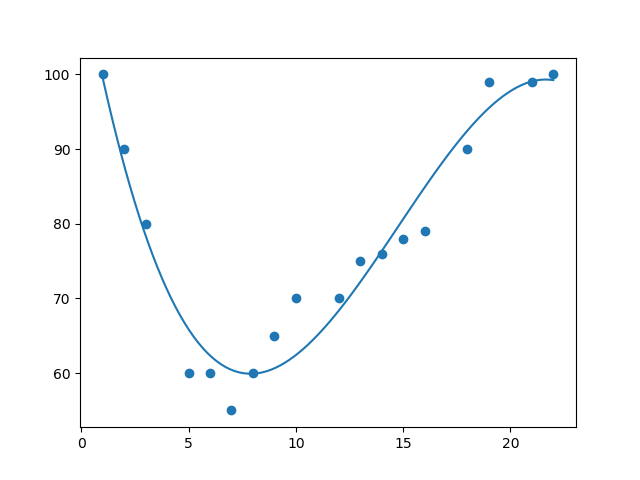线性回归
回归是一种确定一个变量(y)与其他变量(x)之间关系的方法。
在统计学中,线性回归是一种对 y 和 x 之间线性关系进行建模的方法。
在机器学习中,线性回归是一种监督式机器学习算法。
散点图
这是散点图(来自上一章)
示例
const xArray = [50,60,70,80,90,100,110,120,130,140,150];
const yArray = [7,8,8,9,9,9,10,11,14,14,15];
// 定义数据
const data = [{
x:xArray,
y:yArray,
mode: "markers"
}];
// 定义布局
const layout = {
xaxis: {range: [40, 160], title: "平方米"},
yaxis: {range: [5, 16], title: "百万美元"},
title: "房价与面积"
};
Plotly.newPlot("myPlot", data, layout);
自己动手试一试 »
预测值
从上面的散点数据中,我们如何预测未来的价格?
- 使用手绘线性图
- 建模线性关系
- 建模线性回归
线性图
这是一条基于最高价和最低价预测价格的线性图
示例
const xArray = [50,60,70,80,90,100,110,120,130,140,150];
const yArray = [7,8,8,9,9,9,9,10,11,14,14,15];
const data = [
{x:xArray, y:yArray, mode:"markers"},
{x:[50,150], y:[7,15], mode:"line"}
];
const layout = {
xaxis: {range: [40, 160], title: "平方米"},
yaxis: {range: [5, 16], title: "百万美元"},
title: "房价与面积"
};
Plotly.newPlot("myPlot", data, layout);
自己动手试一试 »
来自上一章
线性图可以写成 y = ax + b
其中
- y 是我们要预测的价格
- a 是直线的斜率
- x 是输入值
- b 是截距
线性关系
该模型使用价格和尺寸之间的线性关系来预测价格
示例
const xArray = [50,60,70,80,90,100,110,120,130,140,150];
const yArray = [7,8,8,9,9,9,10,11,14,14,15];
// 计算斜率
let xSum = xArray.reduce(function(a, b){return a + b;}, 0);
let ySum = yArray.reduce(function(a, b){return a + b;}, 0);
let slope = ySum / xSum;
// 生成值
const xValues = [];
const yValues = [];
for (let x = 50; x <= 150; x += 1) {
xValues.push(x);
yValues.push(x * slope);
}
自己动手试一试 »
在上面的例子中,斜率是计算出的平均值,截距为 0。
使用线性回归函数
该模型使用线性回归函数来预测价格
示例
const xArray = [50,60,70,80,90,100,110,120,130,140,150];
const yArray = [7,8,8,9,9,9,10,11,14,14,15];
// 计算总和
let xSum=0, ySum=0 , xxSum=0, xySum=0;
let count = xArray.length;
for (let i = 0, len = count; i < count; i++) {
xSum += xArray[i];
ySum += yArray[i];
xxSum += xArray[i] * xArray[i];
xySum += xArray[i] * yArray[i];
}
// 计算斜率和截距
let slope = (count * xySum - xSum * ySum) / (count * xxSum - xSum * xSum);
let intercept = (ySum / count) - (slope * xSum) / count;
// 生成值
const xValues = [];
const yValues = [];
for (let x = 50; x <= 150; x += 1) {
xValues.push(x);
yValues.push(x * slope + intercept);
}
自己动手试一试 »
多项式回归
如果散点数据不符合线性回归(穿过点的直线),则数据可能符合多项式回归。
多项式回归与线性回归一样,使用变量 x 和 y 之间的关系来找到穿过数据点的最佳绘制线。

